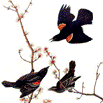Center, Internet, Wildlife Damage Management

Bird Control Seminars Proceedings
Document Type
Article
Date of this Version
September 1970
Abstract
Development of safe bird management techniques has become necessary for the economic survival of many parameters of agriculture. Competition between man and birds for resources has always occurred but has become increasingly complex as the human population increased. As man's demand for additional food and fiber has required more intensive cultivation of arable land, certain birds have caused in¬creasingly costly losses. Bird damage has become so severe in some areas that till¬age of certain crops is threatened.
In some situations, troublesome bird populations can be reduced to tolerable levels; however, the primary objective of bird management should be the alleviation of damage to crops and not destruction of birds. All birds possess beneficial qualities and federal or state laws protect most species. To avoid killing birds and still reduce bird damage to agricultural production, the potentially most useful approach to bird management is the development of non-toxic repellents.
DRC-3324, a butyramide, is a chemical example of this approach to bird management. It was initially examined under laboratory conditions by Denver Wild¬life Research Center scientists following suggestion of candidacy for this purpose by Upjohn personnel. The chemical met all major criteria established for judging the relative potential of compounds for repellent purposes: the effective concentration was very low; the toxic concentration was substantially greater than the repellent level; it was relatively non-toxic to mammals; and was not phytotoxic to corn seed.
The objective of these trials was to evaluate the effectiveness of the chemical under field conditions as a deterrent to red-winged blackbirds (Agelaius phoeniceus) and common grackles (Quiscalus quiscula) damaging freshly planted sweet-corn seed.

